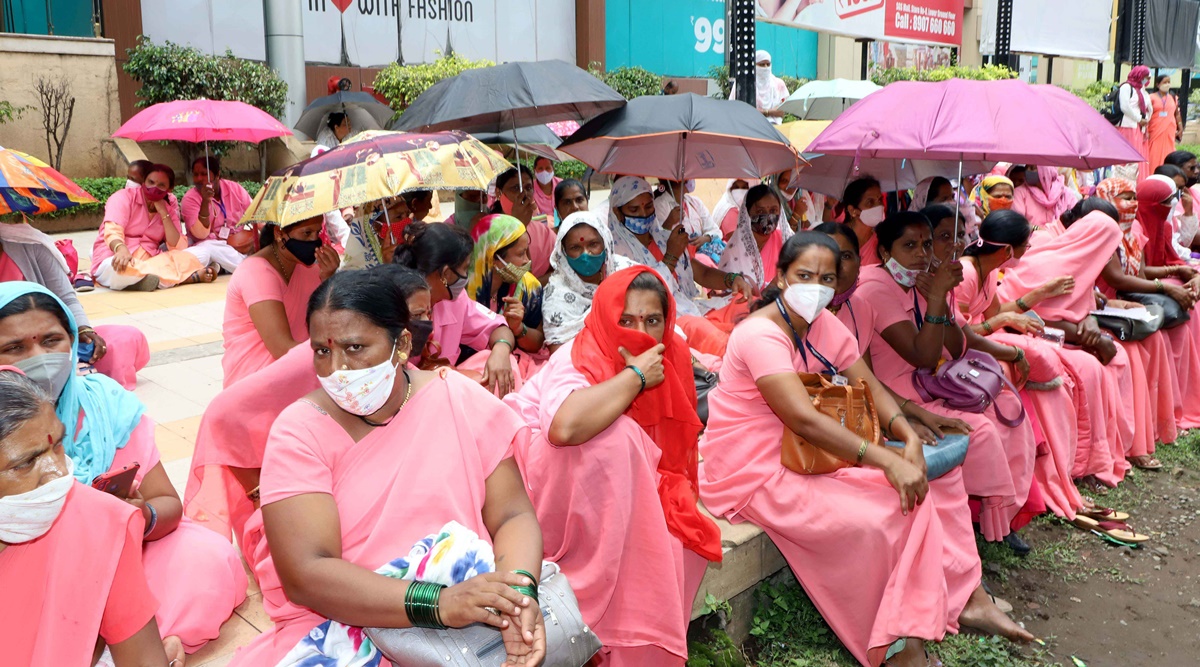 Asha Workers held a protest for demanding fair wages and safety amid the Covid-19 crisis at Pune Zilla Parishad in Camp. Representative Image. (Express File Photo by Pavan)
Asha Workers held a protest for demanding fair wages and safety amid the Covid-19 crisis at Pune Zilla Parishad in Camp. Representative Image. (Express File Photo by Pavan) In a few months, India will celebrate its 74th year of Independence. It will look back at its transformation over the years, while standing on the brink of establishing a New India by 2022. Under PM Narendra Modi, India is currently working towards putting in place a “development state” guided by the philosophy of sabka saath, sabka vikas. The strategy for New India@75 calls for a radical transformation by 2022-23.
What will it take for us to reform?
In the first phase of Covid, we all knew someone who had contracted the virus but the second wave has hit home. A growing realisation amid the mayhem is the importance of the state. Probably, a global recognition. Considering this realisation, what would it mean for us to transform? Let us now apply a gender lens and include half the population. Transforming India will call for a paradigm shift in ensuring effective delivery of essential services to Indian women and girls.
In the last few months, much progress has been made in ensuring that women have access to services and essentials. The Government of India and the Ministry of Women and Child Development launched 701 one-stop Sakhi centres across 34 states/UTs, appraised over Rs 9,288 crore projects and scheme benefits under the Nirbhaya Fund, expanded the Pradhan Mantri Matru Vandana Yojana (PMMVY), a maternity benefit programme that supports pregnant and lactating women with direct benefit transfers, amongst others.
To strengthen the judicial systems that support women and girls across the country, the Centre initiated the integration of the criminal justice system with crime and criminal tracking networks, and a system that operates an investigation tracking system for sexual offences.
Launching an emergency response support team, passing the Criminal Amendment Act, 2019, maintaining systems for ensuring timely investigations and administration of criminal justice, setting up women help desks in police stations and sanctioning eight safe city projects across India, new India is ready for women-led development by empowering women and girls of the nation.
An estimated 736 million women, almost one in three, have been subjected to intimate partner violence, non-partner sexual violence or both at least once in their life, where 30 per cent of women are aged 15 and older, says a report by UNFPA, 2020. Globally, violence response services have reported an increase in demand of up to 500 per cent during the pandemic, reports UN Women in 2020. From the first lockdown on March 24, 2020, India witnessed an increase in the number of cases reporting violence against women across 52 national helplines. The All India Women’s helpline (1091) for immediate assistance attended twice as many support calls from survivors. In active efforts by the Ministry of Women and Child Development to address gender-based violence during the pandemic, we see a progress in sensitisation of the issue as women and girls across the country are now well aware of their rights, resources and recovery opportunities.
The Centre’s efforts to ensure equitable distribution of welfare such as free ration, cooking gas cylinders, insurance cover for health workers and direct benefit bank transfer to a large number of women within a short time, with effective last mile delivery, is reflected in many survey outcomes.
The big difference between the first and second wave of Covid-19 is the re-conception of what was essential services. The government-run “one-stop centres” have helped several women facing violence. One such centre in the eastern city of Cuttack, offers emergency housing, counselling and referral services. Says one employee, Soumya Sahu, “I listen to the survivors, understand their stories, counsel them, and ensure that centre staff are able to provide them with all the necessary care and support. It’s a big job that the centres can’t do on their own. That’s why they have joined forces with the police, the District Legal Services Authority, as well as Women’s Self-Help Groups (SHGs) and college students through rural childcare centres… My staff and I go regularly to schools, colleges, nursing institutes, and neighbourhoods, where we talk with people and conduct training sessions on gender.” (UN India, 2020)
However, the real transformation will come through transformative financing and an integrated approach to women’s rights. Streamlining of the Nirbhaya Fund set up in 2013 by the Union Government to address and end violence against women, is in keeping with the pledge of directing resources to schemes and programmes for gender equality. The fund is for setting up anti-human trafficking units at district level, developing end-to-end cyber security mechanisms, re-designing cities and public services to meet the needs of women, and accelerating justice response through fast-track courts.
The recently launched Mission Shakti by the Ministry of Women and Child Development proposes a comprehensive and coordinated solution to sexual and gender-based violence. Recognising the interlinks between women’s economic empowerment, gender discriminatory social norms and women’s experiences of violence, women’s rehabilitation and empowerment find an important part of the mission strategy through one-stop centres and skilling opportunities at anganwadis.
The Centre’s plan for India @ 75 envisions the progress of its people through the progress of women first.
The writer is deputy country representative, UN Women, office for India, Bhutan, Maldives and Sri Lanka
- The Indian Express website has been rated GREEN for its credibility and trustworthiness by Newsguard, a global service that rates news sources for their journalistic standards.

